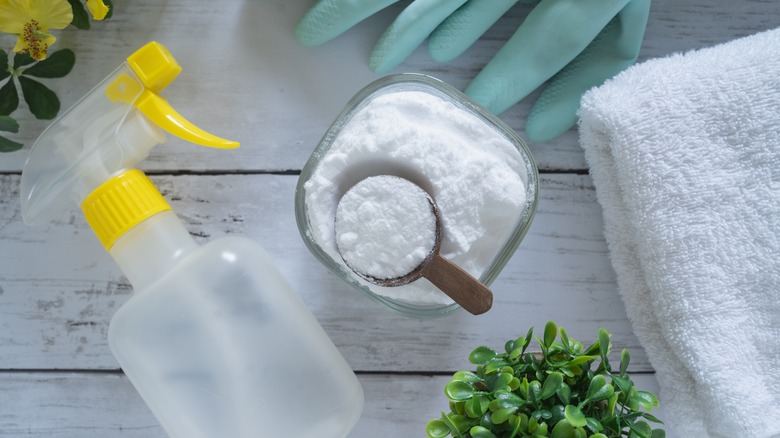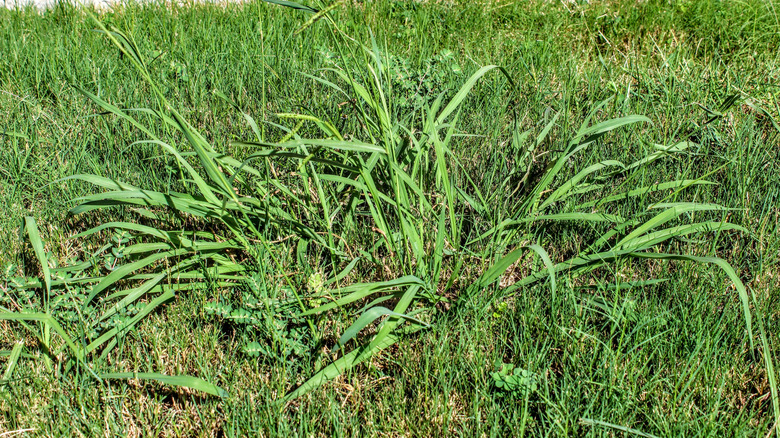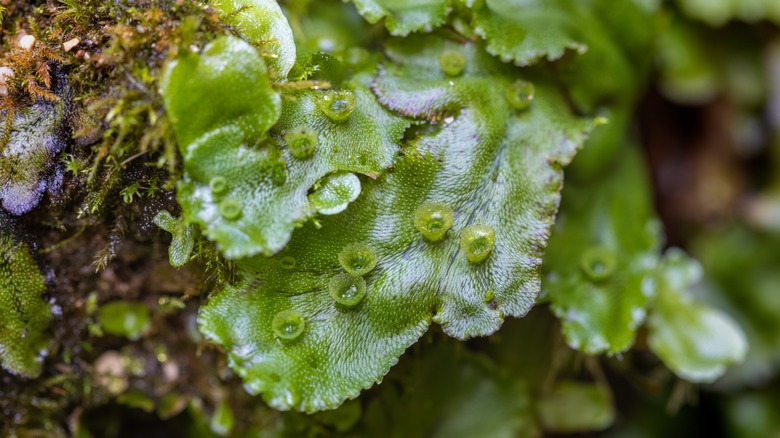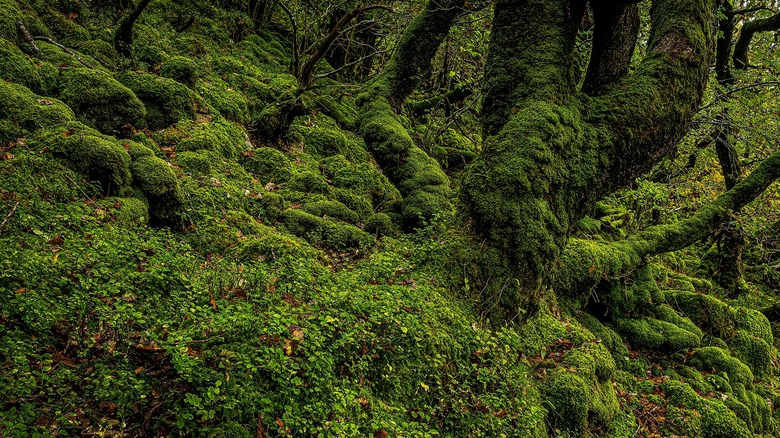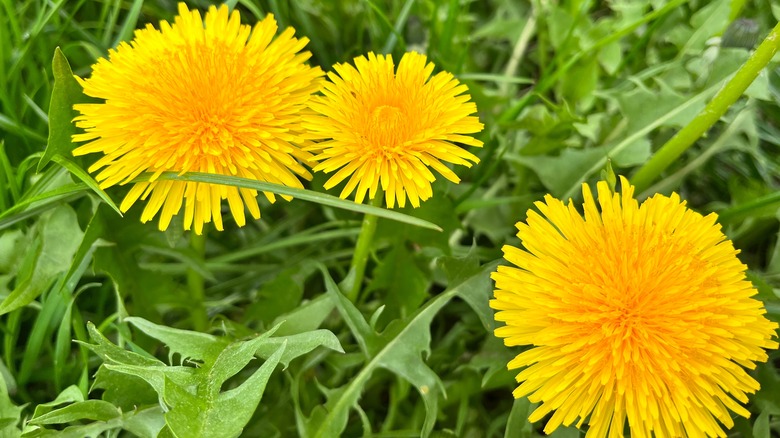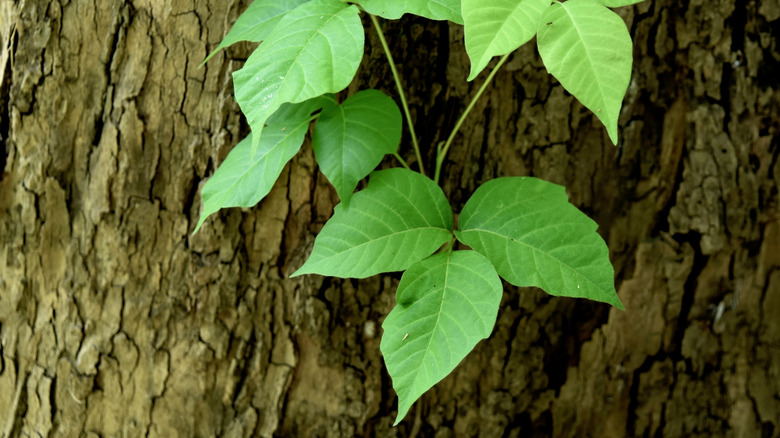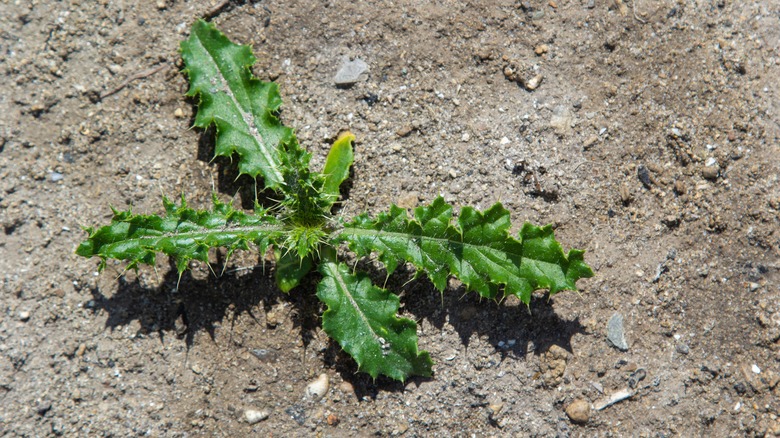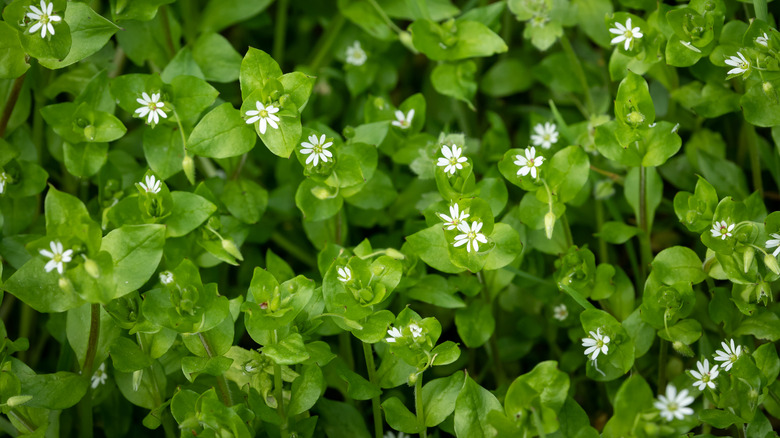7 Types Of Pesky Weeds You Can Control Using Baking Soda
As the weather gets warmer and the gardening season begins, rookie and professional gardeners alike will encounter a perennial problem: unwanted and unsightly weeds. Commercial weed killers are often the go-to solution for these pesky plants, but the heavy chemicals they contain can damage nearby wildlife over time; plus, per the CDC, prolonged exposure to ingredients like glyphosate can cause respiratory distress as well as longer-term threats to human health. If you're looking for a more natural way to eliminate unwanted weeds within your garden, a common household ingredient could be a quick and easy solution to your problems.
Baking soda's alkaline nature and high salinity work to dry out weeds, killing them and preventing regrowth over time. Be warned, however: these useful properties of baking soda will affect all plant life in your garden, so exercise caution when applying your homemade herbicide. Baking soda is a particularly useful solution for weeds growing in isolation — in the cracks of your sidewalk, for instance — but a little creativity and care can make it a helpful spot treatment in larger garden beds and lawns, too. Sprinkle baking soda directly onto weeds, or target them with a spray bottle filled with a solution of baking soda and water (one cup of baking soda per every gallon of water). Here are just a few common weeds that this natural weed-killing hack can tackle.
Crabgrass
If you've taken great care to maintain a pristine lawn, there's nothing more frustrating than an outbreak of crabgrass. This long-stemmed, spindly weed can choke out the grasses you actually want on your lawn by spreading quickly and leaching nutrients from nearby plants. It's also one of the more unsightly weeds you'll find in your yard, growing taller than most non-invasive grasses in large clumps. The variety of crabgrass you're likely to see taking over your yard — large or "hairy" crabgrass — can produce up to 150,000 seeds per plant. It's no wonder a small crabgrass problem can quickly escalate into a yard-wide phenomenon.
Luckily, crabgrass can be bested by baking soda. Apply your solution of baking soda (or baking soda straight from the box) to clusters of crabgrass, taking care not to sprinkle it onto the surrounding grass. As the foliage of the clusters begins to dry up and die, it will be much easier to pull out crabgrass by the roots and prevent further damage to your lawn. If caught in the early days of germination in spring and summer, your crabgrass problem could be kaput before the seeds take over your yard!
Liverwort
You may recognize liverwort (species Marchantia, in technical terms) from its abundance in wet, cool locales such as greenhouses. These alien-looking weeds have flat, branching foliage with small cups on their surfaces, and they prefer nutrient-rich areas such as the growing media used for ornamental plant production. Liverwort will form dense mats that prevent other plants from accessing fertilizer and moisture. While sanitizing greenhouses and keeping media affected by liverworts isolated from other plants may be the best long-term solution to prevent their growth, you can banish existing liverworts from your home greenhouse, terrarium, or shade garden using baking soda.
Liverwort is one of several species that is particularly susceptible to baking soda as a weed treatment. Since baking soda is so effective at drying up vegetation, it makes perfect sense that the moisture-loving liverwort family can't thrive when it's around. You'll know the kitchen product is doing its job once the weed begins turning black.
Moss
Moss, like liverwort, thrives in cool, moist areas; you're most likely to find it in shaded or wooded garden plots, growing atop compost piles, or decorating the sides of trees and container gardens if the conditions are right. You may not consider moss to be a weed and may even want to propagate it intentionally in your yard: moss lawns can thrive in shaded areas, eliminate the need for mowing, and can be a sustainable alternative to grass in drought-affected regions. But some seek to rid their lawns of moss as it interrupts a yard's neat aesthetic — moss can make pathways slippery and choke out light to greenhouses. If you'd rather not encourage moss to find a home on pots, stepping stones, and other damp areas in the garden, look no further than a baking soda treatment. Moss tends to thrive in acidic, poorly draining soil, so applying an alkaline baking soda solution can be enough to increase your soil's pH and make moss disappear.
Dandelions
Dandelions have their benefits — their leaves and roots are edible, and the plants have a history of use in herbal medicine. They can also contribute to the health of your lawn, with taproots that can aid in aerating your soil and flowers that attract pollinators to your yard. But if foraging isn't your thing, and you find the abundance of these fluffy yellow flowers overwhelming, it may be time to break out the baking soda. While there are a variety of ways to control dandelion growth on your lawn or in your garden, this method is among the gentler, less invasive ways to dry up unwanted dandelion foliage before it goes to seed. Many sources note that dandelions can be tricky to treat with natural weed killers such as baking soda because of their extensive underground taproot systems, which drying agents might not reach. Consider baking soda for a temporary aesthetic solution to a dandelion problem (that won't permanently banish these useful plants), or be prepared to reapply baking soda if sprouts return after several weeks.
Poison ivy
Unlike a few other plants in this list, there is no ambiguity when it comes to poison ivy: it is most certainly a weed and a harmful one at that. Exposure to the oil that these notorious leaves of three produce, called urushiol, provokes an allergic reaction in most people — and according to the American Academy of Dermatologists, even those who do not initially have a reaction to urushiol can develop the allergy with continued exposure to poison ivy, sumac, and oak. While the itchy rash caused by poison ivy isn't contagious from person to person, the oils of this bothersome plant can stick to clothing and pet fur and affect anyone who comes into contact with them from contaminated items. Natural weed killers such as vinegar, salt, and boiling water can kill poison ivy, so we have reason to believe that baking soda should work, too: since a major factor in baking soda's effectiveness against unwanted plants is its high salinity, it should have a similar effect to salt in this case.
Adding dish or castile soap in small quantities to a baking soda solution can help it adhere to the leaves of weeds — a critical consideration when treating plants that you shouldn't physically touch, like poison ivy. If accidental exposure to poison ivy does occur, baking soda can once again come in handy. Applying a solution of three parts baking soda and one part water to a poison ivy rash can help with itchiness.
Thistle
If you're gardening in North America, chances are you've encountered the prickly, jagged leaves of Canada thistle. First introduced to the Americas through seed shipments from Europe in the 1600s, this annoying plant can literally be a pain to remove, with sharp barbs on its leaves. Canada thistle is an especially tall and enterprising weed, growing up to five feet tall and producing lots of seeds that will eventually choke out other vegetation through large root systems.
Gardeners frustrated with thistle's deep roots and sharp spines may find themselves pulling fruitlessly at these invasive plants with their thickest pair of gardening gloves. Here's where natural weed-banishing solutions such as undiluted vinegar and baking soda can help put the final nail in the coffin of stubborn thistle plants. First, use shears to cut down the foliage of the thistle as close as possible to the root of the plant; then, apply a strong concentration of your natural weed killer to the base of the remaining stem, reapplying as necessary until the roots themselves are dead.
Chickweed
Chickweed may have an adorable name — drawn from the fact that chickens and other birds enjoy grazing on it — but this invasive plant is anything but cute when it begins taking over your lawn or garden. You can spot chickweed by its pointed leaves and small white flowers, which grow almost anywhere: chickweed can grow in both sun and shade, in many different types of soil, and in a variety of turf. Even so, the presence of chickweed can tell you something about the health of your lawn, particularly if your local soil is prone to compacting or an excess of nitrogen.
Baking soda can be used on chickweed just as it works on other quick-spreading lawn nuisances, such as crabgrass, by simply applying it to the base of the plant. As with other natural solutions, baking soda won't permanently rid your lawn of annual weeds like chickweed, but it can keep them under control and prevent a total takeover.
